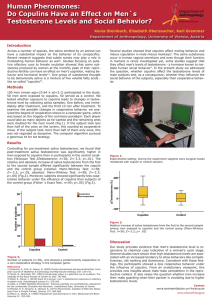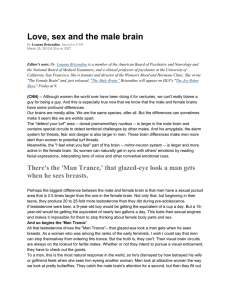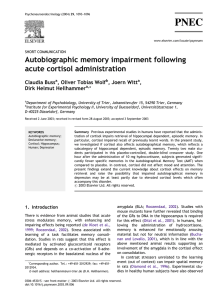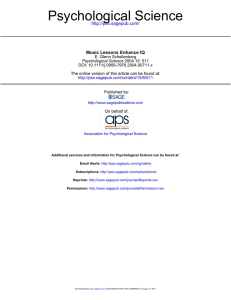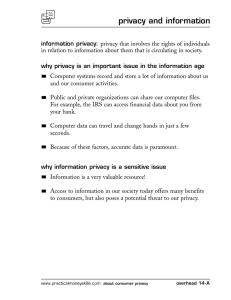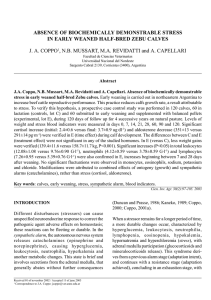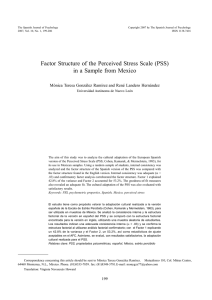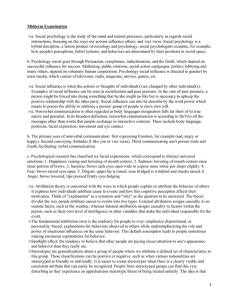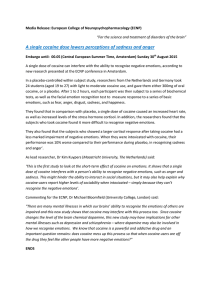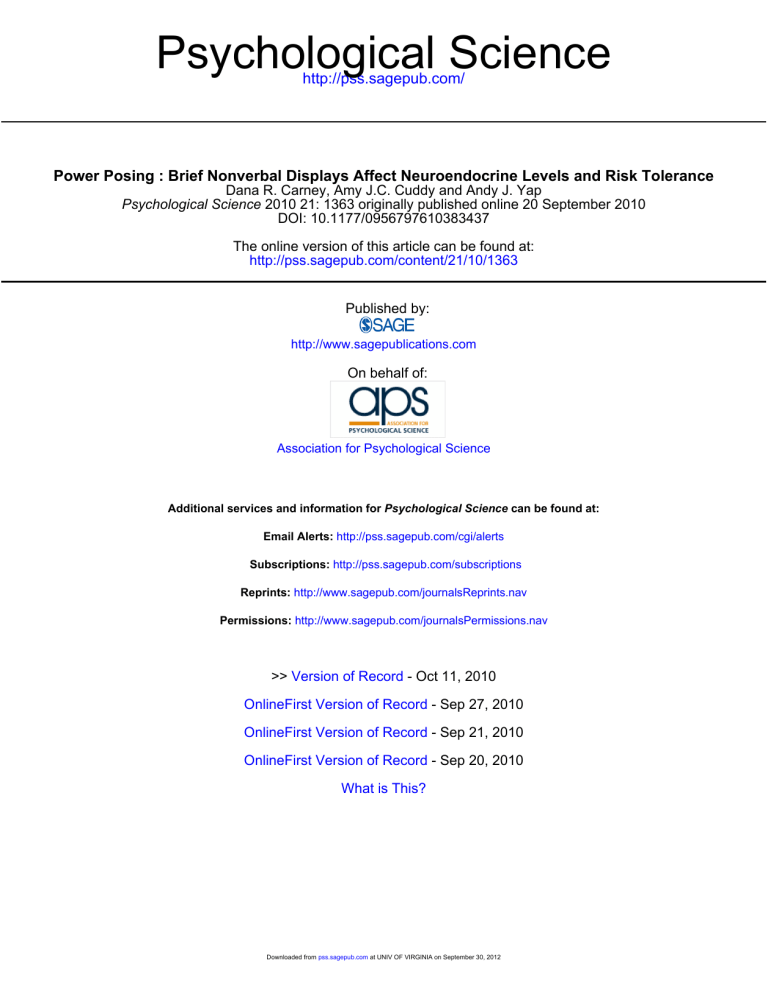
Psychological Science http://pss.sagepub.com/ Power Posing : Brief Nonverbal Displays Affect Neuroendocrine Levels and Risk Tolerance Dana R. Carney, Amy J.C. Cuddy and Andy J. Yap Psychological Science 2010 21: 1363 originally published online 20 September 2010 DOI: 10.1177/0956797610383437 The online version of this article can be found at: http://pss.sagepub.com/content/21/10/1363 Published by: http://www.sagepublications.com On behalf of: Association for Psychological Science Additional services and information for Psychological Science can be found at: Email Alerts: http://pss.sagepub.com/cgi/alerts Subscriptions: http://pss.sagepub.com/subscriptions Reprints: http://www.sagepub.com/journalsReprints.nav Permissions: http://www.sagepub.com/journalsPermissions.nav >> Version of Record - Oct 11, 2010 OnlineFirst Version of Record - Sep 27, 2010 OnlineFirst Version of Record - Sep 21, 2010 OnlineFirst Version of Record - Sep 20, 2010 What is This? Downloaded from pss.sagepub.com at UNIV OF VIRGINIA on September 30, 2012 Research Report Power Posing: Brief Nonverbal Displays Affect Neuroendocrine Levels and Risk Tolerance Psychological Science 21(10) 1363­–1368 © The Author(s) 2010 Reprints and permission: sagepub.com/journalsPermissions.nav DOI: 10.1177/0956797610383437 http://pss.sagepub.com Dana R. Carney1, Amy J.C. Cuddy2, and Andy J. Yap1 1 Columbia University and 2Harvard University Abstract Humans and other animals express power through open, expansive postures, and they express powerlessness through closed, contractive postures. But can these postures actually cause power? The results of this study confirmed our prediction that posing in high-power nonverbal displays (as opposed to low-power nonverbal displays) would cause neuroendocrine and behavioral changes for both male and female participants: High-power posers experienced elevations in testosterone, decreases in cortisol, and increased feelings of power and tolerance for risk; low-power posers exhibited the opposite pattern. In short, posing in displays of power caused advantaged and adaptive psychological, physiological, and behavioral changes, and these findings suggest that embodiment extends beyond mere thinking and feeling, to physiology and subsequent behavioral choices. That a person can, by assuming two simple 1-min poses, embody power and instantly become more powerful has real-world, actionable implications. Keywords cortisol, embodiment, hormones, neuroendocrinology, nonverbal behavior, power, risk taking, testosterone Received 1/20/10; Revision accepted 4/8/10 The proud peacock fans his tail feathers in pursuit of a mate. By galloping sideways, the cat manipulates an intruder’s perception of her size. The chimpanzee, asserting his hierarchical rank, holds his breath until his chest bulges. The executive in the boardroom crests the table with his feet, fingers interlaced behind his neck, elbows pointing outward. Humans and other animals display power and dominance through expansive nonverbal displays, and these power poses are deeply intertwined with the evolutionary selection of what is “alpha” (Darwin, 1872/2009; de Waal, 1998). But is power embodied? What happens when displays of power are posed? Can posed displays cause a person to feel more powerful? Do people’s mental and physiological systems prepare them to be more powerful? The goal of our research was to test whether high-power poses (as opposed to low-power poses) actually produce power. To perform this test, we looked at the effects of high-power and low-power poses on some fundamental features of having power: feelings of power, elevation of the dominance hormone testosterone, lowering of the stress hormone cortisol, and an increased tolerance for risk. Power determines greater access to resources (de Waal, 1998; Keltner, Gruenfeld, & Anderson, 2003); higher levels of agency and control over a person’s own body, mind, and positive feelings (Keltner et al., 2003); and enhanced cognitive function (Smith, Jostmann, Galinsky, & van Dijk, 2008). Powerful individuals (compared with powerless individuals) demonstrate greater willingness to engage in action (Galinsky, Gruenfeld, & Magee, 2003; Keltner et al., 2003) and often show increased risk-taking behavior1 (e.g., Anderson & Galinsky, 2006). The neuroendocrine profiles of the powerful differentiate them from the powerless, on two key hormones—testosterone and cortisol. In humans and other animals, testosterone levels both reflect and reinforce dispositional and situational status and dominance; internal and external cues cause testosterone to rise, increasing dominant behaviors, and these behaviors can elevate testosterone even further (Archer, 2006; Mazur & Corresponding Authors: Dana R. Carney, Columbia University, Graduate School of Business, 717 Uris Hall, 3022 Broadway, New York, NY 10027-6902 E-mail: dcarney@columbia.edu Amy J.C. Cuddy, Harvard Business School, Baker Library 449, Boston, MA 02163 E-mail: acuddy@hbs.edu Downloaded from pss.sagepub.com at UNIV OF VIRGINIA on September 30, 2012 1364 Carney et al. Booth, 1998). For example, testosterone rises in anticipation of a competition and as a result of a win, but drops following a defeat (e.g., Booth, Shelley, Mazur, Tharp, & Kittok, 1989), and these changes predict the desire to compete again (Mehta & Josephs, 2006). In short, testosterone levels, by reflecting and reinforcing dominance, are closely linked to adaptive responses to challenges. Power is also linked to the stress hormone cortisol: Power holders show lower basal cortisol levels and lower cortisol reactivity to stressors than powerless people do, and cortisol drops as power is achieved (Abbott et al., 2003; Coe, Mendoza, & Levine, 1979; Sapolsky, Alberts, & Altmann, 1997). Although short-term and acute cortisol elevation is part of an adaptive response to challenges large (e.g., a predator) and small (e.g., waking up), the chronically elevated cortisol levels seen in low-power individuals are associated with negative health consequences, such as impaired immune functioning, hypertension, and memory loss (Sapolsky et al., 1997; Segerstrom & Miller, 2004). Low-power social groups have a higher incidence of stress-related illnesses than high-power social groups do, and this is partially attributable to chronically elevated cortisol (Cohen et al., 2006). Thus, the power holder’s typical neuroendocrine profile of high testosterone coupled with low cortisol—a profile linked to such outcomes as disease resistance (Sapolsky, 2005) and leadership abilities (Mehta & Josephs, 2010)—appears to be optimally adaptive. It is unequivocal that power is expressed through highly specific, evolved nonverbal displays. Expansive, open postures (widespread limbs and enlargement of occupied space by spreading out) project high power, whereas contractive, closed postures (limbs touching the torso and minimization of occupied space by collapsing the body inward) project low power. All of these patterns have been identified in research on actual and attributed power and its nonverbal correlates (Carney, Hall, & Smith LeBeau, 2005; Darwin, 1872/2009; de Waal, 1998; Hall, Coats, & Smith LeBeau, 2005). Although researchers know that power generates these displays, no research has investigated whether these displays generate power. Will posing these displays of power actually cause individuals to feel more powerful, focus on reward as opposed to risk, and experience increases in testosterone and decreases in cortisol? In research on embodied cognition, some evidence suggests that bodily movements, such as facial displays, can affect emotional states. For example, unobtrusive contraction of the “smile muscle” (i.e., the zygomaticus major) increases enjoyment (Strack, Martin, Stepper, 1988), the head tilting upward induces pride (Stepper & Strack, 1993), and hunched postures (as opposed to upright postures) elicit more depressed feelings (Riskind & Gotay, 1982). Approach-oriented behaviors, such as touching, pulling, or nodding “yes,” increase preference for objects, people, and persuasive messages (e.g., Briñol & Petty, 2003; Chen & Bargh, 1999; Wegner, Lane, & Dimitri, 1994), and fist clenching increases men’s self-ratings on power-related traits (Schubert & Koole, 2009). However, no research has tested whether expansive power poses, in comparison with contractive power poses, cause mental, physiological, and behavioral change in a manner consistent with the effects of power. We hypothesized that high-power poses (compared with low-power poses) would cause individuals to experience elevated testosterone, decreased cortisol, increased feelings of power, and higher risk tolerance. Such findings would suggest that embodiment goes beyond cognition and emotion and could have immediate and actionable effects on physiology and behavior. Method Participants and overview of procedure Forty-two participants (26 females and 16 males) were randomly assigned to the high-power-pose or low-power-pose condition. Participants believed that the study was about the science of physiological recordings and was focused on how placement of electrocardiography electrodes above and below the heart could influence data collection. Participants’ bodies were posed by an experimenter into high-power or low-power poses. Each participant held two poses for 1 min each. Participants’ risk taking was measured with a gambling task; feelings of power were measured with self-reports. Saliva samples, which were used to test cortisol and testosterone levels, were taken before and approximately 17 min after the power-pose manipulation. Power poses Poses were harvested from the nonverbal literature (e.g., Carney et al., 2005; Hall et al., 2005) and varied on the two nonverbal dimensions universally linked to power: expansiveness (i.e., taking up more space or less space) and openness (i.e., keeping limbs open or closed). The two high-power poses into which participants were configured are depicted in Figure 1, and the two low-power poses are depicted in Figure 2. To be sure that the poses chosen conveyed power appropriately, we asked 95 pretest participants to rate each pose from 1 (very low power) to 7 (very high power). High-power poses (M = 5.39, SD = 0.99) were indeed rated significantly higher on power than were low-power poses (M = 2.41, SD = 0.93), t(94) = 21.03, p < .001; r = .99. To be sure that changes in neuroendocrine levels, powerful feelings, or behavior could be attributed only to the highpower or low-power attributes of the poses, we had 19 pretest participants rate the comfort, difficulty, and pain of the poses. Participants made all four poses (while wearing electrocardiography leads) and completed questionnaires after each pose. There were no differences between high-power and low-power poses on comfort, t(16) = 0.24, p > .80; difficulty, t(16) = 0.77, p > .45; or painfulness, t(16) = –0.82, p > .42. Downloaded from pss.sagepub.com at UNIV OF VIRGINIA on September 30, 2012 1365 Power Posing Fig. 1. The two high-power poses used in the study. Participants in the high-power-pose condition were posed in expansive positions with open limbs. Fig. 2. The two low-power poses used in the study. Participants in the low-power-pose condition were posed in contractive positions with closed limbs. To configure the test participants into the poses, the experimenter placed an electrocardiography lead on the back of each participant’s calf and underbelly of the left arm and explained, “To test accuracy of physiological responses as a function of sensor placement relative to your heart, you are being put into a certain physical position.” The experimenter then manually configured participants’ bodies by lightly touching their arms and legs. As needed, the experimenter provided verbal Downloaded from pss.sagepub.com at UNIV OF VIRGINIA on September 30, 2012 1366 Carney et al. instructions (e.g., “Keep your feet above heart level by putting them on the desk in front of you”). After manually configuring participants’ bodies into the two poses, the experimenter left the room. Participants were videotaped; all participants correctly made and held either two high-power or two low-power poses for 1 min each. While making and holding the poses, participants completed a filler task that consisted of viewing and forming impressions of nine faces. Time 1, F(1, 41) = 17.40, p < .001, r = .55, and Time 2, F(1, 41) = 22.55, p < .001, r = .60. To control for sex differences in testosterone, we used participant’s sex as a covariate in all analyses. All hormone analyses examined changes in hormones observed at Time 2, controlling for Time 1. Analyses with cortisol controlled for testosterone, and vice versa.2 Measure of risk taking and powerful feelings One-way analyses of variance examined the effect of power pose on postmanipulation hormones (Time 2), controlling for baseline hormones (Time 1). As hypothesized, high-power poses caused an increase in testosterone compared with low-power poses, which caused a decrease in testosterone, F(1, 39) = 4.29, p < .05; r = .34 (Fig. 3). Also as hypothesized, high-power poses caused a decrease in cortisol compared with low-power poses, which caused an increase in cortisol, F(1, 38) = 7.45, p < .02; r = .43 (Fig. 4). Also consistent with predictions, high-power posers were more likely than low-power posers to focus on rewards— 86.36% took the gambling risk (only 13.63% were risk averse). In contrast, only 60% of the low-power posers took the risk (and 40% were risk averse), χ2(1, N = 42) = 3.86, p < .05; Φ = .30. Finally, high-power posers reported feeling significantly more “powerful” and “in charge” (M = 2.57, SD = 0.81) than low-power posers did (M = 1.83, SD = 0.81), F(1, 41) = 9.53, p < .01; r = .44. Thus, a simple 2-min power-pose manipulation was enough to significantly alter the physiological, mental, and feeling states of our participants. The implications of these results for everyday life are substantial. After they finished posing, participants were presented with the gambling task. They were endowed with $2 and told they could keep the money—the safe bet—or roll a die and risk losing the $2 for a payoff of $4 (a risky but rational bet; odds of winning were 50/50). Participants indicated how “powerful” and “in charge” they felt on a scale from 1 (not at all) to 4 (a lot). Saliva collection and analysis Testing was scheduled in the afternoon (12:00 p.m.–6:00 p.m.) to control for diurnal rhythms in hormones. Saliva samples were taken before the power-pose manipulation (approximately 10 min after arrival; Time 1) and again 17 min after the power-pose manipulation (M = 17.28 min, SD = 4.31; Time 2). Standard salivary-hormone collection procedures were used (Dickerson & Kemeny, 2004; Schultheiss & Stanton, 2009). Before providing saliva samples, participants did not eat, drink, or brush their teeth for at least 1 hr. Participants rinsed their mouths with water and chewed a piece of sugarfree Trident Original Flavor gum for 3 min to stimulate salivation (this procedure yields the least bias compared with passive drool procedures; Dabbs, 1991). Participants provided approximately 1.5 ml of saliva through a straw into a sterile polypropylene microtubule. Samples were immediately frozen to avoid hormone degradation and to precipitate mucins. Within 2 weeks, samples were packed in dry ice and shipped for analysis to Salimetrics (State College, PA), where they were assayed in duplicate for salivary cortisol and salivary testosterone using a highly sensitive enzyme immunoassay. For cortisol, the intra-assay coefficient of variation (CV) was 5.40% for Time 1 and 4.40% for Time 2. The average interassay CV across high and low controls for both time points was 2.74%. Cortisol levels were in the normal range at both Time 1 (M = 0.16 μg/dl, SD = 0.19) and Time 2 (M = 0.12 μg/dl, SD = 0.08). For testosterone, the intra-assay CV was 4.30% for Time 1 and 3.80% for Time 2. The average interassay CV across high and low controls for both time points was 3.80%. Testosterone levels were in the normal range at both Time 1 (M = 60.30 pg/ml, SD = 49.58) and Time 2 (M = 57.40 pg/ml, SD = 43.25). As would be suggested by appropriately taken and assayed samples (Schultheiss & Stanton, 2009), men were higher than women on testosterone at both Results Discussion Our results show that posing in high-power displays (as opposed to low-power displays) causes physiological, psychological, and behavioral changes consistent with the literature on the effects of power on power holders—elevation of the dominance hormone testosterone, reduction of the stress hormone cortisol, and increases in behaviorally demonstrated risk tolerance and feelings of power. These findings advance current understanding of embodied cognition in two important ways. First, they suggest that the effects of embodiment extend beyond emotion and cognition, to physiology and subsequent behavioral choice. For example, as described earlier, nodding the head “yes” leads a person to be more easily persuaded when listening to a persuasive appeal, and smiling increases humor responses. We suggest that these simple behaviors, a head nod or a smile, might also cause physiological changes that activate an entire trajectory of psychological, physiological, and behavioral shifts—essentially altering the course of a person’s day. Second, these results suggest that any psychological construct, such as power, with a signature pattern of nonverbal correlates may be embodied. Downloaded from pss.sagepub.com at UNIV OF VIRGINIA on September 30, 2012 1367 Power Posing 0.06 16.00 12.00 0.04 Cortisol Change (μg/dl) Testosterone Change (pg/ml) 8.00 4.00 0.00 –4.00 –8.00 0.02 0.00 –0.02 –0.04 –12.00 –0.06 –16.00 Low-Power High-Power Poses Fig. 3. Mean changes in the dominance hormone testosterone following high-power and low-power poses. Changes are depicted as difference scores (Time 2 – Time 1). Error bars represent standard errors of the mean. These results also offer a methodological advance in research on power. Many reported effects of power are limited by the methodological necessity of manipulating power in a laboratory setting (e.g., complex role assignments). The simple, elegant power-pose manipulation we employed can be taken directly into the field and used to investigate ordinary people in everyday contexts. Is it possible that our findings are limited to the specific poses utilized in this experiment? Although the power-infusing attribute of expansiveness and the poses that capture it require further investigation, findings from an additional study (N = 49) suggest that the effects reported here are not idiosyncratic to these specific poses. In addition to the poses used in the current report, an additional three high-power poses and an additional three low-power poses produced the same effects on feelings of power, F(1, 48) = 4.38, p < .05, r = .30, and risk taking, χ2(1, N = 49) = 4.84, p < .03, Φ = .31. By simply changing physical posture, an individual prepares his or her mental and physiological systems to endure difficult and stressful situations, and perhaps to actually improve confidence and performance in situations such as interviewing for jobs, speaking in public, disagreeing with a High-Power Low-Power Poses Fig. 4. Mean changes in the stress hormone cortisol following high-power and low-power poses. Changes are depicted as difference scores (Time 2 – Time 1). Error bars represent standard errors of the mean. boss, or taking potentially profitable risks. These findings suggest that, in some situations requiring power, people have the ability to “fake it ’til they make it.” Over time and in aggregate, these minimal postural changes and their outcomes potentially could improve a person’s general health and well-being. This potential benefit is particularly important when considering people who are or who feel chronically powerless because of lack of resources, low hierarchical rank in an organization, or membership in a low-power social group. Acknowledgments We are gratefully indebted to the following individuals for their insight, support, and assistance with this research: Daniel Ames, Max Bazerman, Joe Ferrero, Alan Fiske and lab, Adam Galinsky, Deborah Gruenfeld, Lucia Guillory, Brian Hall, Bob Josephs, Brian Lucas, Malia Mason, Pranj Mehta, Michael Morris, Joe Navarro, Michael Norton, Thomas Schubert, Steve Stroessner, and Bill von Hippel. Declaration of Conflicting Interests The authors declared that they had no conflicts of interest with respect to their authorship or the publication of this article. Downloaded from pss.sagepub.com at UNIV OF VIRGINIA on September 30, 2012 1368 Carney et al. Notes 1. The effect of power on risk taking is moderated by factors such as prenatal exposure to testosterone (Ronay & von Hippel, in press). 2. Cortisol scores at both time points were sufficiently normally distributed, except for two outliers that were more than 3 standard deviations above the mean and were excluded; testosterone scores at both time points were sufficiently normally distributed, except for one outlier that was more than 3 standard deviations above the mean and was excluded. References Abbott, D.H., Keverne, E.B., Bercovitch, F.B., Shively, C.A., Mendoza, S.P., Saltzman, W., et al. (2003). Are subordinates always stressed? A comparative analysis of rank differences in cortisol levels among primates. Hormones and Behavior, 43, 67–82. Anderson, C., & Galinsky, A.D. (2006). Power, optimism, and the proclivity for risk. European Journal of Social Psychology, 36, 511–536. Archer, J. (2006). Testosterone and human aggression: An evaluation of the challenge hypothesis. Neuroscience & Biobehavioral Reviews, 30, 319–345. Booth, A., Shelley, G., Mazur, A., Tharp, G., & Kittok, R. (1989). Testosterone and winning and losing in human competition. Hormones and Behavior, 23, 556–571. Briñol, P., & Petty, R.E. (2003). Overt head movements and persuasion: A self-validation analysis. Journal of Personality and Social Psychology, 84, 1123–1139. Carney, D.R., Hall, J.A., & Smith LeBeau, L. (2005). Beliefs about the nonverbal expression of social power. Journal of Nonverbal Behavior, 29, 105–123. Chen, M., & Bargh, J.A. (1999). Consequences of automatic evaluation: Immediate behavioral predispositions to approach or avoid the stimulus. Personality and Social Psychology Bulletin, 25, 215–224. Coe, C.L., Mendoza, S.P., & Levine, S. (1979). Social status constrains the stress response in the squirrel monkey. Physiology & Behavior, 23, 633–638. Cohen, S., Schwartz, J.E., Epel, E., Kirschbaum, C., Sidney, S., & Seeman, T. (2006). Socioeconomic status, race, and diurnal cortisol decline in the Coronary Artery Risk Development in Young Adults (CARDIA) study. Psychosomatic Medicine, 68, 41–50. Dabbs, J.M. (1991). Salivary testosterone measurements: Collecting, storing, and mailing saliva samples. Physiology & Behavior, 42, 815–817. Darwin, C. (2009). The expression of the emotions in man and animals. New York, NY: Oxford. (Original work published 1872) de Waal, F. (1998). Chimpanzee politics: Power and sex among apes. Baltimore, MD: Johns Hopkins University Press. Dickerson, S.S., & Kemeny, M.E. (2004). Acute stressors and cortisol responses: A theoretical integration and synthesis of laboratory research. Psychological Bulletin, 130, 355–391. Galinsky, A.D., Gruenfeld, D.H., & Magee, J.C. (2003). From power to action. Journal of Personality and Social Psychology, 87, 327–339. Hall, J.A., Coats, E.J., & Smith LeBeau, L. (2005). Nonverbal behavior and the vertical dimension of social relations: A meta-analysis. Psychological Bulletin, 131, 898–924. Keltner, D., Gruenfeld, D.H., & Anderson, C. (2003). Power, approach, and inhibition. Psychological Review, 110, 265–284. Mazur, A., & Booth, A. (1998). Testosterone and dominance in men. Behavioral & Brain Sciences, 21, 353–397. Mehta, P.H., & Josephs, R.A. (2006). Testosterone change after losing predicts the decision to compete again. Hormones and Behavior, 50, 684–692. Mehta, P.H., & Josephs, R.A. (2010). Dual-hormone regulation of dominance. Manuscript in preparation. Riskind, J.H., & Gotay, C.C. (1982). Physical posture: Could it have regulatory or feedback effects on motivation and emotion? Motivation and Emotion, 6, 273–298. Ronay, R., & von Hippel, W. (in press). Power, testosterone and risktaking: The moderating influence of testosterone and executive functions. Journal of Behavioral Decision Making. Sapolsky, R.M. (2005). The influence of social hierarchy on primate health. Science, 308, 648–652. Sapolsky, R.M., Alberts, S.C., & Altmann, J. (1997). Hypercortisolism associated with social subordinance or social isolation among wild baboons. Archives of General Psychiatry, 54, 1137–1143. Schubert, T.W., & Koole, S.L. (2009). The embodied self: Making a fist enhances men’s power-related self-conceptions. Journal of Experimental Social Psychology, 45, 828–834. Schultheiss, O.C., & Stanton, S.J. (2009). Assessment of salivary hormones. In E. Harmon-Jones & J.S. Beer (Eds.), Methods in the neurobiology of social and personality psychology (pp. 17–44). New York, NY: Guilford. Segerstrom, S., & Miller, G. (2004). Psychological stress and the human immune system: A meta-analytic study of 30 years of inquiry. Psychological Bulletin, 130, 601–630. Smith, P.K., Jostmann, N.B., Galinsky, A.D., & van Dijk, W.W. (2008). Lacking power impairs executive functions. Psychological Science, 19, 441–447. Stepper, S., & Strack, F. (1993). Proprioceptive determinants of emotional and nonemotional feelings. Journal of Personality and Social Psychology, 64, 211–220. Strack, F., Martin, L.L., & Stepper, S. (1988). Inhibiting and facilitating conditions of the human smile: A nonobtrusive test of the facial feedback hypothesis. Journal of Personality and Social Psychology, 54, 768–777. Wegner, D.M., Lane, J.D., & Dimitri, S. (1994). The allure of secret relationships. Journal of Personality and Social Psychology, 66, 287–300. Downloaded from pss.sagepub.com at UNIV OF VIRGINIA on September 30, 2012
